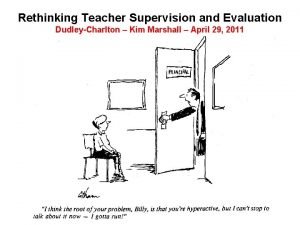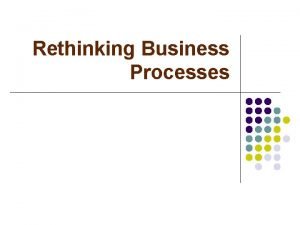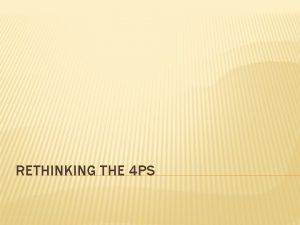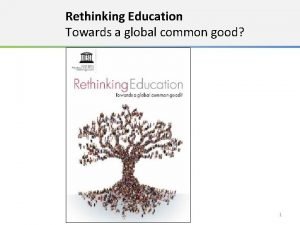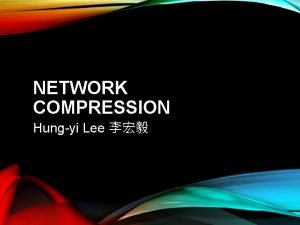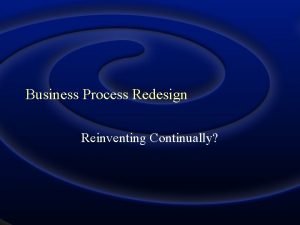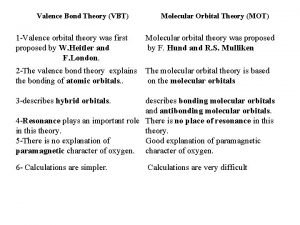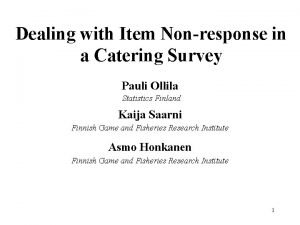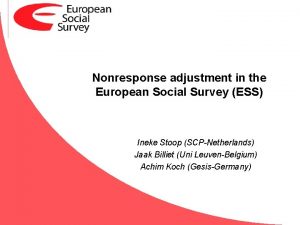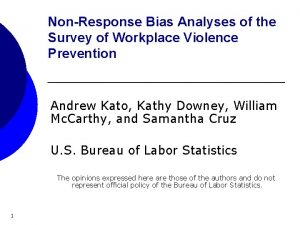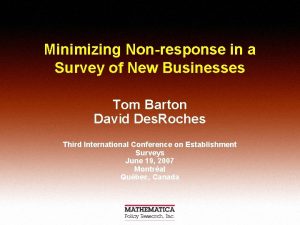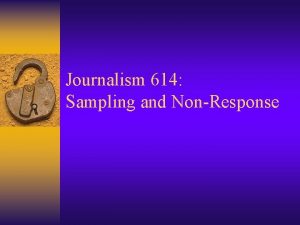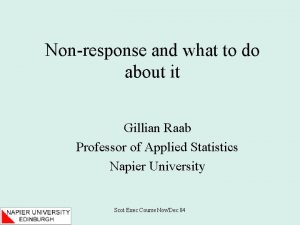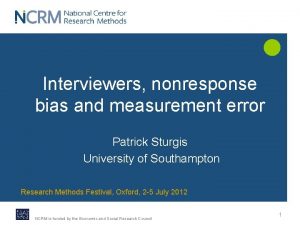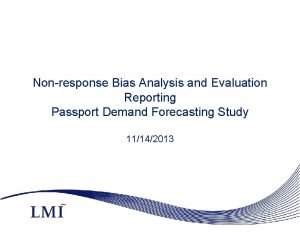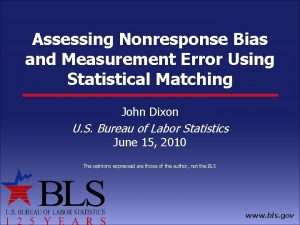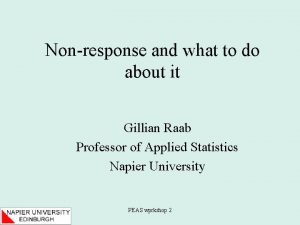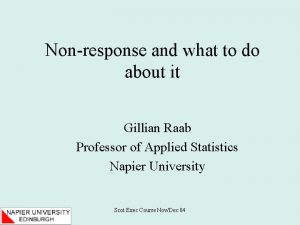Rethinking LeverageSalience Theory and Causes of Survey Nonresponse


























- Slides: 26

Rethinking Leverage-Salience Theory and Causes of Survey Nonresponse: Integrating Emotion, Mood, and Affect into Theory of Nonresponse Matt Jans US Census Bureau, Statistical Research Division Rachel Levenstein Michigan Program in Survey Methodology University of Michigan

Scope • What makes up leverage? – Affect v. Reasoned judgment • Application of random effects w/in LST – Affect – Design features

Leverage-Salience Theory (LST) (Groves, Singer, & Corning, 2000) • Addresses correlates and causes of unit refusal nonresponse • Probability of response for the individual is a combination of – Leverage of a survey attribute – Salience of the same survey attribute

Visual Model of LST Groves, Singer, & Corning (2000), p. 300

Definition and Examples of Leverage • “The sample person’s assessment of a particular attribute of a survey” (Groves, et al. , 2000) – Incentive: Economic need or social exchange – Survey Topic: Interest in or commitment to issue – Survey Mode: Enjoyment of or aversion to interacting w/ a live person (e. g. , temperament or social isolation)

Definition and Examples of Salience • Awareness of the sampled person to the survey feature – Explanation of topic, mode, incentive in cover letter or interviewer recruitment script – Obvious presence of survey feature (e. g. , $5 bill clipped to survey; Interviewer on doorstep)

Decomposing Leverage = Valence + Distance Valence is positive or negative – Positively valenced features dispose the sampled person toward participation – Negatively valenced features dispose the sample person toward refusal

Focus of the Talk Leverage Salience Theory Leverage Valence Affect Integral Reason Incidental Salience Distance Another Paper Another Paper

Decomposing Valence – No explicit distinction between causes of valence • All cognitive, emotional, judgmental psychological actions are pooled Affective Positive Negative Interacting with people makes me feel good Interacting with people makes me feel uncomfortable This interviewer seems pleasant This interviewer’s voice irritates me That organization makes my blood boil Reasoned I think this topic is important Given the current economic situation, the government would benefit from my opinion on this issue The size of the incentive relative to the time the survey will take and my income is unreasonable

Definitions of Affect • Affect – Mood • Non-directed, lower-intensity, longer-lasting – Emotion • Directed at an object/cause, higher-intensity, acute

Affect and Decision Making • “Feelings as Information” perspective • Affect impacts/operates in information processing, judgment and memory (Schwarz & Clore, 2007) • We often make judgments and decisions on affective or emotional information (Schwarz & Clore, 2007; Schwarz, 2000) • We perceive the world emotionally first (Zajonc, 1980)

Major Findings on Affect and Decision Making • Depressed v. positive mood • Strong arguments more effective for people in sad or negative moods, than positive moods (Schwarz, 2000) • Mood will influence responses unless there is an attributable cause – Weather & well-being (Schwarz & Clore, 1983)

Incorporating Affect into LST

Incorporating Affect into LST • Affect related to design features (integral affect) – Like or dislike interacting with another person or not (SAQ v. Iwr Admin Modes)? – Feel that the incentive is a “fair trade” or manipulative? – Does R have strong feelings (positive or negative) about the survey topic or sponsor?

Incorporating Affect into LST • Random effect of design features – Design feature is one realization of similar features (e. g. levels of incentive, personalization of letter) – Repeated measures from different levels-features across same R’s ln[pij/(1 -pij)]=B 0 + B 1 ij. Aff. Desij + B 2 i. Sij + u 1 i. Aff. Desij + eij i=Respondent , j=Design Feature

Incorporating Affect into LST • Affect unrelated to design features (incidental affect) – The mind state we happen upon when requesting survey participation • Daily/weekly variation in mood • Individual variation in mood • Societal variation in mood (e. g. , anxious mood due to economic situation; saturation with polling)

Incorporating Affect into LST • Random effect of respondent – Respondent’s propensity may change over time irrespective of design feature – Repeated measures from same respondent receiving same design features ln[pij/(1 -pij)]=B 0 + B 1 ij. Aff. Respij + B 2 i. Si + u 1 i. Aff. Respij + eij i=Respondent , j=Recruitment Attempt

Collection of Measures • Voice and speech indicators of mood • Respondent speech (spoken words) – Coded for affective content • “I don’t feel comfortable answering questions about my sex life” • Interviewer or observer rating of affect • Respondent rating of own affector design featares

Collection of Measures • Complexity of measures will depend on definition of affect – Integral: Affect related to survey design features • Measures collected from initial contact with R – Incidental: Affect unrelated to survey • Voice at contact • Measures need to be taken outside of the interaction with the survey • Non-contact v. Refusal • Panel data helpful

Links to Other Error Sources • Measurement Error – Response by individuals with only positive affective states would bias measures of affect or wellbeing – Identifying current mood & assigning it to a cause (e. g. weather) can change satisfaction reports • Item Nonresponse – Similar mechanisms & opportunities for tailoring apply

International Component • Cultural differences in social cognition & emotion (Markus & Kitayama, 1991)

References Bachorowski, J. A. (1999). Vocal expression and perception of emotion. Current Directions in Psychological Science, 8(2), 53 -57. Groves, R. M. , Couper, M. P. , Presser, S. , Singer, E. , Tourangeau, R. , Acosta, G. P. , & Nelson, L. (2006). Experiments in producing nonresponse bias. Public Opinion Quarterly, 70(5), 720 -736. Groves, R. M. , Presser, S. , & Dipko, S. (2004). The role of topic interest in survey participation decisions. Public Opinion Quarterly, 68(1), 2 -31. Groves, R. M. , Singer, E. , & Corning, A. (2000). Leverage-saliency theory of survey participation: Description and an illustration. Public Opinion Quarterly, 64(3), 299 -308. Markus HR, Kitayama S. Culture and the self: Implications for cognition, emotion, and motivation. Psychological Review. 1991; 98(2): 224 -253. Available at: http: //doi. apa. org/getdoi. cfm? doi=10. 1037/0033 -295 X. 98. 2. 224. Roose, H. , Lievens, J. , & Waege, H. (2007). The joint effect of topic interest and follow-up procedures on the response in a mail questionnaire: An empirical test of the leveragesaliency theory in audience research. Sociological Methods & Research, 35(3), 410. Schwarz, N. (2000). Emotion, cognition, and decision making. Cognition and Emotion, 14(4), 433440. Schwarz N, Clore GL. Mood, misattribution, and judgments of well-being: Informative and directive functions of affective states. Journal of Personality and Social Psychology. 1983; 45(3): 513 -523. Available at: http: //content. apa. org/journals/psp/45/3/513. Schwarz, N. , & Clore, G. L. (2007). Feelings and emotional experiences. In A. W. Kruglanski, & E. T. Higgins, Social Psychology: Handbook of Basic Principles, (pp. 385 -407). Guilford Press. Zajonc, R. B. (1980). Feeling and thinking: Preferences need no inferences. American Psychologist, 35(2), 151 -175.

Thank You • matthew. e. jans@census. gov • mlev@isr. umich. edu

LST Findings • “Peripheral” aspects of surveys (e. g. , incentive, follow-up protocol) have larger impact in absence of personal relevance of topic (Groves, et al. , 2000; Roose, Lievens, & Waege, 2007) • Personal relevance does not always lead to increased response (Groves, Couper, Presser, et al, 2006; Groves, Presser, & Dipko, 2004)

Understanding Leverage • Hard to measure – Internal, subjective – Group membership • Decompose leverage into components to facilitate measurement • Affective v. reasoned perceptions and judgments of survey request

Integrating Affect into Survey Practice • Tailoring to affect states – “I’m sure you’ve had a busy day” if calling in evening – Listen for vocal cues indicating unease and tailor – Different information/arguments required for different moods – Moods may be changeable
 Rethinking teacher supervision and evaluation
Rethinking teacher supervision and evaluation Rethinking business process
Rethinking business process Cdio example
Cdio example Rethinking the 4 p's
Rethinking the 4 p's Ubígua
Ubígua Rethinking education: towards a global common good?
Rethinking education: towards a global common good? Rethinking file mapping for persistent memory
Rethinking file mapping for persistent memory Arxiv
Arxiv Rethinking file mapping for persistent memory
Rethinking file mapping for persistent memory Radical redesign of business processes
Radical redesign of business processes Acls secondary survey
Acls secondary survey Ultimate vs proximate causation
Ultimate vs proximate causation Altruistic acts examples
Altruistic acts examples Causes and effects of the french and indian war
Causes and effects of the french and indian war A remarkable turnaround case study
A remarkable turnaround case study Continental drift
Continental drift Continental drift theory and plate tectonics theory
Continental drift theory and plate tectonics theory Difference between classical theory and neoclassical theory
Difference between classical theory and neoclassical theory Motivation in group formation
Motivation in group formation Hawthorne theory of motivation
Hawthorne theory of motivation Adjusted retention time
Adjusted retention time Lien theory vs title theory
Lien theory vs title theory X and y theory
X and y theory Game theory and graph theory
Game theory and graph theory What is vbt
What is vbt Molecular orbitals shapes
Molecular orbitals shapes Theory x and theory y
Theory x and theory y
